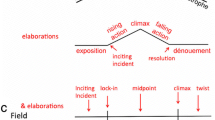Abstract
The article explores the interrelationship between Hans-Georg Gadamer’s and Gerard Genette’s application of Plato’s concept of mimesis. At first sight, Gadamer’s hermeneutical aesthetics and Genette’s structuralist narratology seem to have nothing in common. Whereas Gadamer believes in an ontological foundation of aesthetic experience, Genette only pays attention to the linguistic structure of a text. Even the way in which they approach Plato’s theory of mimesis could not be more different. Gadamer denies Plato’s notion of mimesis as bad imitation and defines mimesis as representation; in contrast to this, Genette acknowledges Platos’s distinction between diegesis as narrative and mimesis as imitation. Nevertheless, both theoretical approaches share a rather vague and metaphorical usage of mimesis that is mainly concerned with the relationship between the form and the content of mimetic representation. I will argue that Gadamer’s and Genette’s concepts of mimesis can be read as reciprocal commentaries on each other which illuminate their own rhetorical strategies.
Similar content being viewed by others
Literatur
Einen Überblick über die Rezeption der Mimesis im 20. Jahrhundert gibt Potolsky, Matthew: Mimesis, New York, London 2006, S. 113–156. Allerdings bleiben dabei die wichtigen hermeneutischen Positionen von Gadamer und Ricœur dabei ebenso unberücksichtigt wie Genettes strukturalistische Narratologie.
Vgl. Derrida, Jacques: Economimesis. In: Diacritics 11 (1981), S. 3–25.
Vgl. Lacoue-Labarthe, Philippe: Typography. Mimesis, Philosophy, Politics. Cambride/London 1989.
Gadamer, Hans-Georg: Wahrheit und Methode. Grundzüge einer philosophischen Hermeneutik. Gesammelte Werke Bd. 1. Tübingen 72010.
Ricœur, Paul: Zeit und Erzählung Bd. I: Zeit und historische Erzählung. München 1988.
Vgl. u. a. Schweiker, William: Beyond Imitation: Mimetic Praxis in Gadamer, Ricœur, and Derrida. In: The Journal of Religion 68/1 (1988), S. 21–38.
Vgl. Auerbach, Erich: Mimesis. Dargestellte Wirklichkeit in der abendländischen Literatur. Tübingen/Basel 102001.
Gadamer selbst gebraucht diesen Ausdruck nicht. Allerdings kann Gadamers Argumentation durchaus in Analogie zu Heideggers Erzählung von der Seinsvergessenheit betrachtet werden. Überhaupt ließe sich Gadamers philosophische Ästhetik in mancher Hinsicht als eine Art Heidegger-Mimikry lesen. Im Hinblick auf den Mimesis-Begriff setzt sich Gadamer jedoch deutlich von Heidegger ab, dessen Kunstkonzeption keineswegs eine Rehabilitierung der Mimesis impliziert (vgl. Sallis, John: »The Hermeneutics of the Artwork«. In: Günter Figal [Hg.]: Hans-Georg Gadamer: Wahrheit und Methode. Klassiker Auslegen. Berlin 2007, S. 39–50, hier: S. 45 f.).
Gadamer, Hans-Georg: »Dichtung und Mimesis«. In: Hans-Georg Gadamer: Ästhetik und Poetik I. Kunst als Aussage. Gesammelte Werke Bd. 8. Tübingen 1993, S. 80–85, hier: S. 81.
Vgl. Martin Heidegger: Der Ursprung des Kunstwerkes. Stuttgart 1990.
Aristoteles: Poetik. Hg. u. übers. Manfred Fuhrmann. Stuttgart 2006, 1448b.
Platon: Der Staat. Hg. u. übers. Karl Vretska. Stuttgart 1988, 598b.
Hier nur auf den Passus im 10. Buch der Politeia bezogen. Der Mimesis-Begriff bei Platon ist bekanntlich alles andere als einheitlich und in sich kongruent. Vgl. hierzu u. a. Büttner, Stefan: Literatur und Mimesis bei Platon. In: Jörg Schönert/ Ulrike Zeuch (Hg.): Mimesis–Repräsentation–Imitation. Literaturtheoretische Positionen von Aristoteles bis zum Ende des 18. Jahrhunderts. Berlin u. a. 2004, S. 31–64.
Vgl. Genette, Gérard: Die Erzählung. München 21998, S. 116.
Homer: Ilias. Übers. Wolfgang Schadewaldt. Frankfurt a. M. 1975, I. Gesang, V. 33–36.
Vgl. Barthes, Roland: Der Wirklichkeitseffekt. In: Ders.: Das Rauschen der Sprache. Frankfurt a. M. 32012, S. 164–172.
Vgl. Käte Hamburger: Die Logik der Dichtung. München 1987, S. 207 f.
Genette, Gérard: Fiktion und Diktion. München 1992, S. 16 f.
Author information
Authors and Affiliations
Corresponding author
Rights and permissions
About this article
Cite this article
Brandes, P. »Mimesiseffekt« oder »Was-Gehalt des Dargestellten«? Zur Funktion des Mimesis-Begriffs bei Gadamer und Genette. Z Literaturwiss Linguistik 44, 150–160 (2014). https://doi.org/10.1007/BF03379989
Published:
Issue Date:
DOI: https://doi.org/10.1007/BF03379989




